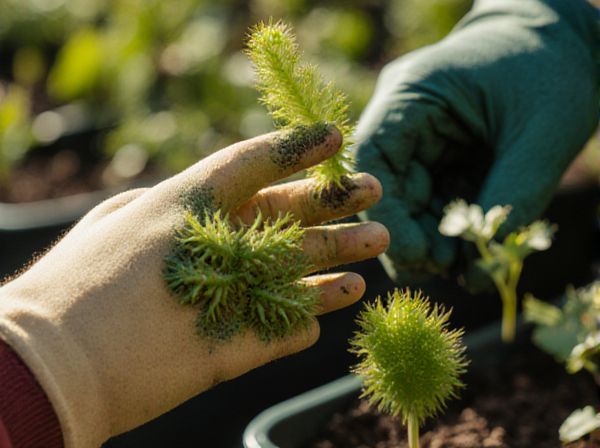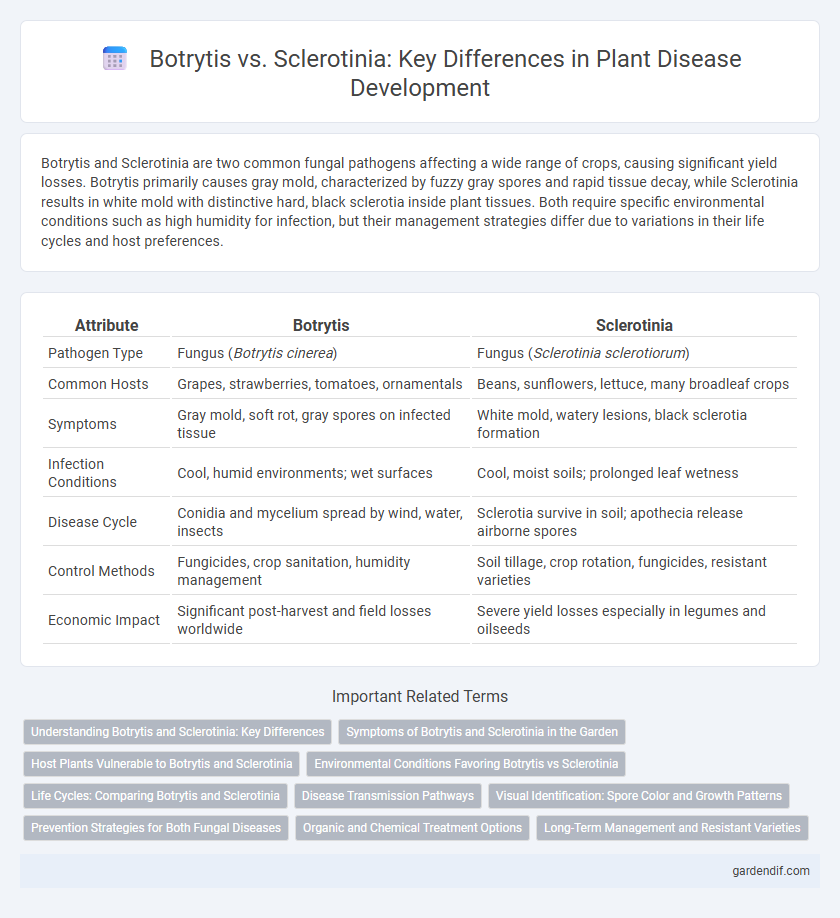
Botrytis vs Sclerotinia Illustration
Botrytis and Sclerotinia are two common fungal pathogens affecting a wide range of crops, causing significant yield losses. Botrytis primarily causes gray mold, characterized by fuzzy gray spores and rapid tissue decay, while Sclerotinia results in white mold with distinctive hard, black sclerotia inside plant tissues. Both require specific environmental conditions such as high humidity for infection, but their management strategies differ due to variations in their life cycles and host preferences.
Table of Comparison
| Attribute | Botrytis | Sclerotinia |
|---|---|---|
| Pathogen Type | Fungus (Botrytis cinerea) | Fungus (Sclerotinia sclerotiorum) |
| Common Hosts | Grapes, strawberries, tomatoes, ornamentals | Beans, sunflowers, lettuce, many broadleaf crops |
| Symptoms | Gray mold, soft rot, gray spores on infected tissue | White mold, watery lesions, black sclerotia formation |
| Infection Conditions | Cool, humid environments; wet surfaces | Cool, moist soils; prolonged leaf wetness |
| Disease Cycle | Conidia and mycelium spread by wind, water, insects | Sclerotia survive in soil; apothecia release airborne spores |
| Control Methods | Fungicides, crop sanitation, humidity management | Soil tillage, crop rotation, fungicides, resistant varieties |
| Economic Impact | Significant post-harvest and field losses worldwide | Severe yield losses especially in legumes and oilseeds |
Understanding Botrytis and Sclerotinia: Key Differences
Botrytis and Sclerotinia are fungal pathogens causing diseases in a variety of plants, but Botrytis primarily induces gray mold while Sclerotinia leads to white mold or stem rot. Botrytis cinerea thrives in humid, moderate temperatures and affects flowers, leaves, and fruit, whereas Sclerotinia sclerotiorum prefers cool, wet conditions targeting stems and crowns. Effective management strategies differ, with Botrytis control relying on fungicides and environmental modifications, while Sclerotinia requires crop rotation and soil treatments to break sclerotia survival structures.
Symptoms of Botrytis and Sclerotinia in the Garden
Botrytis, commonly known as gray mold, presents symptoms including fuzzy gray spores on leaves, wilting, and soft, water-soaked lesions primarily on flowers and fruits. Sclerotinia, or white mold, manifests as water-soaked lesions that quickly develop into cottony white fungal growth with hard, black sclerotia forming on stems and leaves. Both diseases cause plant tissue decay but differ in fungal structure and host tissue preference, important for garden disease identification and management.
Host Plants Vulnerable to Botrytis and Sclerotinia
Botrytis primarily affects a wide range of host plants including strawberries, grapes, and ornamental flowers, thriving in humid conditions that promote gray mold. Sclerotinia targets crops such as soybeans, sunflowers, and lettuce, causing white mold that damages stems and leaves. Both pathogens pose significant risks to agricultural productivity through their distinct host preferences and infection mechanisms.
Environmental Conditions Favoring Botrytis vs Sclerotinia
Botrytis cinerea thrives in cool, humid environments with frequent leaf wetness, typically around 15-22degC and high relative humidity above 85%, promoting gray mold development on various crops. Sclerotinia sclerotiorum favors slightly warmer temperatures between 15-25degC combined with moist soil and dense canopy conditions that enhance the survival and germination of sclerotia, leading to white mold outbreaks. Understanding these specific environmental conditions is crucial for effective disease management and prevention strategies in agriculture.
Life Cycles: Comparing Botrytis and Sclerotinia
Botrytis cinerea primarily overwinters as sclerotia or mycelium on plant debris, releasing airborne conidia that infect host plants during cool, humid conditions. In contrast, Sclerotinia sclerotiorum survives as durable sclerotia in soil, which germinate to produce apothecia that release ascospores infecting plants in warm, moist environments. Both pathogens exhibit saprophytic and parasitic phases, but their reproductive strategies and environmental triggers for spore release differ significantly in their life cycles.
Disease Transmission Pathways
Botrytis cinerea primarily spreads through air-borne conidia that infect host tissues via wounds or natural openings, facilitated by high humidity and moderate temperatures. Sclerotinia sclerotiorum transmits mainly through soil-borne sclerotia that germinate and produce apothecia, releasing airborne ascospores that infect plants through flowers, stems, or leaves. Understanding these distinct transmission pathways is crucial for implementing effective disease management strategies in agricultural systems.
Visual Identification: Spore Color and Growth Patterns
Botrytis spores typically appear grayish-brown and form fuzzy, dense mats on infected plant surfaces, while Sclerotinia spores are white to cream-colored with a cottony or fluffy growth pattern. Botrytis cinerea produces conidia in clustered, spherical structures known as conidiophores, whereas Sclerotinia sclerotiorum develops large, black sclerotia and white mycelial mats. Visual differentiation between these pathogens relies on observing spore color intensity and the distinct texture of their growth during early infection stages.
Prevention Strategies for Both Fungal Diseases
Effective prevention strategies for Botrytis and Sclerotinia include maintaining proper field sanitation to remove infected plant debris and implementing crop rotation with non-host crops to disrupt the fungal life cycle. Employing resistant cultivars and optimizing plant spacing enhances air circulation, reducing humidity levels that favor fungal growth. Fungicide applications timed according to disease forecasting models also play a crucial role in minimizing infection rates for both fungal pathogens.
Organic and Chemical Treatment Options
Botrytis cinerea and Sclerotinia sclerotiorum are fungal pathogens commonly managed through both organic and chemical treatments. Organic options for Botrytis include neem oil, potassium bicarbonate, and beneficial microbes like Trichoderma species, while chemical treatments often rely on fungicides such as chlorothalonil and fenhexamid. Sclerotinia control in organic systems involves crop rotation, calcium applications, and biocontrol agents like Coniothyrium minitans, with chemical options including boscalid and iprodione fungicides targeting sclerotinia stem rot.
Long-Term Management and Resistant Varieties
Botrytis cinerea and Sclerotinia sclerotiorum require distinct long-term management strategies due to their differing biology and infection cycles. Crop rotation with non-host species, maintaining proper field sanitation, and applying fungicides based on disease forecasting models are essential for managing Botrytis, while Sclerotinia demands extended crop rotations and soil treatments to reduce sclerotia viability. Developing and planting resistant varieties such as Botrytis-resistant grapes or Sclerotinia-resistant sunflower hybrids significantly enhances disease control and reduces reliance on chemical inputs.
Botrytis vs Sclerotinia Infographic

 gardendif.com
gardendif.com